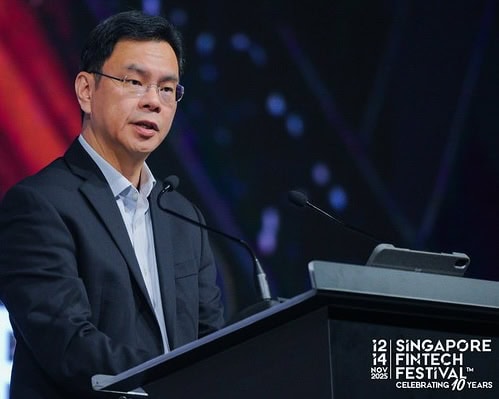New guardrails and common standards are necessary to fuel the next wave of digital transformation in the financial sector, where artificial intelligence (AI) unsurprisingly will take centrestage.
New business models have reshaped financial services, where robo advisors have widened access to wealth management and multi-currency mobile wallets have eased cross-border payments, said Chia Der Jiun, managing director of Monetary Authority of Singapore (MAS), during his speech Thursday at Singapore Fintech Festival 2025.
“Our expanding fintech ecosystem has brought new solutions, lower cost, greater convenience, and more choice to retail and corporate customers,” Chia said.
He then singled out AI and tokenisation as the two transformative waves that will transform the sector in the next decade.

On AI, he noted that Singapore’s financial sector has been leveraging the technology to augment its workforce in general work processes, including information search, summarisation, speech-to-text translation, and first draft generation.
There are more than 1,800 fintech companies in the country, including startups that offer AI-powered products such as fraud detection and chatbots, he said.
Robust guardrails essential as AI autonomy grows
Financial institutions, too, have been using autonomous agents in more complex processes, such as processing credit applications and administering standard insurance claims.
However, agentic autonomy must come with sufficient guardrails, Chia said, adding that Singapore wants financial institutions to adopt AI both productively and safely.
It aims to do this through various efforts that encompass governance, building up AI competencies, and providing resources to guide adoption.
These have resulted in more than 30 financial institutions setting up local AI competency centres, he said.
The Singapore government also has worked to provide more regulatory clarity, he noted.
For instance, MAS in 2023 launched an industry consortium, called Project MindForge, to address AI risks and governance. It published an AI risk framework in early-2024 to highlight key risks around the use of AI.
“As AI adoption in the financial industry grows, governance and safety are essential,” Chia said. “In fact, one of the key factors determining the pace of AI use, and the extent of AI autonomy permitted in work processes, is the robustness of guardrails and controls over the AI lifecycle.”
To further facilitate this, MAS on Thursday released a set of guidelines on AI risk management, detailing the regulator’s expectations for financial institutions to identify AI risks and implement controls across the entire AI lifecycle.
These include capabilities and capacity needed for the use of AI, and roles of the board and senior management in implementing risk management frameworks and policies.
The guidelines cover different AI applications and technologies, including generative AI (GenAI) and AI agents. They also encompass the implementation of controls in key areas, such as data management, transparency and explainability, and human oversight.
The guidelines are principles-based, rather than prescriptive, and set up “flexible guardrails to enable responsible innovation in a fast-moving space”, Chia said.
Concurrently, the Project MindForge consortium also published an AI Risk Management Executive Handbook, which establishes the key components of good AI risk management.
“The guidelines and handbook will work together,” Chia explained, noting that the guidelines require risk materiality assessments and the latter provides examples of how such assessments are carried out.
“The two initiatives constitute our approach towards safe and responsible AI adoption,” he said.
In addition, a separate document detailing actionable insights and industry best practices is slated to be released next year, he added.
This will serve as a companion guide for financial institutions implementing MAS’ AI risk management guidelines, he said.
The consortium also announced a new initiative, BuildFin.ai, to facilitate collaboration between technology vendors, research institutes, and financial institutions, and provide resources for the FSI sector.
For starters, Singapore statutory board A*STAR will partner financial institutions to develop a voice-to-text AI model for the sector, to transcribe conversations in Singlish and the country’s commonly used languages and dialects.
Singlish is a colloquial English-based spoken language often used in Singapore, which incorporates words from other languages including Chinese and Malay.
AI can bring benefits across the financial sector and to consumers and businesses, Chia said.
However, like floods, uncontrolled AI use can also bring consumer harm and risks to financial stability, he said.
“So there needs to be governance and guardrails for safe adoption, and training of the workforce to work with AI,” he noted. “This is what we have set out to do in collaboration with the financial industry.”
Common standards needed to facilitate transactions
Such cooperation also is needed to drive the sector’s other transformative wave -- tokenisation.
Industry observers believe more financial assets will be tokenised, traded, and settled on chain, leading to greater efficiencies and liquidity in transacting multiple assets on interconnected ledgers, Chia noted.
When tokenised, financial assets potentially can be exchanged on a programmable platform in real-time, and with pre-determined conditions encoded, without the need for intermediaries.
Common use cases include smart contracts that facilitate self-executing contractual processes. All are touted to result in less time lag, lower cost, and potentially lower risk.
However, significant progress still is needed to achieve these benefits, Chia said.
Asset-based tokens need to be standardised and networks interoperable. There also must be a deep pool of safe and reliable settlement assets, as well as institutional-grade networks, he said.
“For asset-backed tokens to be transacted on a network, they need to be embedded with standardised data and features that every participant on the network can recognise,” he explained.
Currently, though, banks are building their own networks and rushing to scale, creating different infrastructures that have different technical specifications.
This means that asset-backed tokens issued on one network may not be portable to another network, or at least not without friction, he said.
It also could lead a fragmented landscape of sub-scale walled gardens or a small number of monopolies posing concentration risks, he added.
To avoid such scenarios, the financial industry must collaborate to build a marketplace for asset-backed tokens, even whilst competing to bring products and clients to the market.
“They need to agree on common standards for asset-backed tokens, even as they compete to scale,” Chia said. “And they need to design their networks to be open and interoperable, so that asset-backed tokens issued on one network can be transacted on another.”
It will ensure bond or fund tokens on one network can be recognised and accepted by participants of another network, he added.
He noted that MAS has been working with global policymakers and major financial institutions to develop standards for tokenisation.
The regulator also is collaborating with these organisations to drive network interoperability, developing common principles and standards that network builders can adopt.
These efforts are parked under its Project Guardian and Global Layer One initiatives.
Banking the next billion
Finding common ground also is critical to further bridge the digital divide and drive financial inclusion.
The world’s unbanked population currently is estimated at 1.3 billion, down from 2 billion in 2015 and 3 billion in 2011.
Banking the next billion, though, will likely prove more challenging as it requires reaching users outside of urban populations, according to delegates at the fintech conference.
There still are many who remain disconnected from the internet and modern communications and, hence, the digital economy, said Richard Verma, chief administrative officer at Mastercard, during a panel discussion on the Global South.
And while some may have mobile phones, not all will have access to the necessary training and education, Verma said.
There also are other challenges, such as affordability, he added.
Global South, and Global North, nations are broadly regarded to have lower level of economic and industrial development, and are sometimes referred to as developing economies.
There first needs to be more cohesion to bring these populations into the digital fold, said Veerathai Santiprabhob, a former governor of the Bank of Thailand.
He noted that there often were varying viewpoints even within the public sector, where regulators from the FSI and telecommunications industries might not agree on what was needed to support a national initiative, such as digital identity.
There also are different interests within the private sector, which will require strong will from governments to resolve, Santiprabhob said.
Plugging such gaps is essential to address challenges in banking the next billion, he said, adding that there needs to be incentives or infrastructure on which key stakeholders can come together.
He suggested the possibility of establishing a new group of trusted partners within the ecosystem, that can serve as coordinators between regulators and industry players.





